
St. Michael's Church is a historic Episcopal church at 225 West 99th Street and Amsterdam Avenue on Manhattan's Upper West Side in New York City. The parish was founded on the present site in January 1807, at that time in the rural Bloomingdale District. The present limestone Romanesque building, the third on the site, was built in 1890–91 to designs by Robert W. Gibson and added to the National Register of Historic Places in 1996.

The Church of the Holy Trinity is an historic Episcopal church at 381 Main Street in Middletown, Connecticut. Completed in 1874, it is one of the city's finest examples of Gothic Revival architecture. Its nearby former rectory, also known as the Bishop Acheson House, is one of its finest Colonial Revival houses. The two buildings were listed on the National Register of Historic Places in 1979.

Charles Coolidge Haight was an American architect who practiced in New York City. He designed most of the buildings at Columbia College's now-demolished old campus on Madison Avenue, and designed numerous buildings at Yale University, many of which have survived. He designed the master plan and many of the buildings on the campus of the General Theological Seminary in Chelsea, New York, most of which have survived. Haight's architectural drawings and photographs are held in the Dept. of Drawings and Archives at the Avery Architectural and Fine Arts Library at Columbia University in New York City.
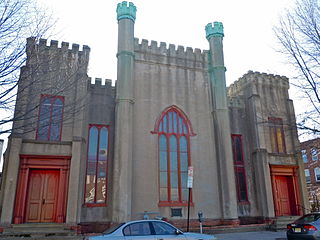
Established in 1703, St. Michael's Church in downtown Trenton, Mercer County, New Jersey, United States, is a founding parish of the Episcopal Diocese of New Jersey. Its present building located at 140 North Warren Street was built in 1747–1748, and was renovated in 1810 and 1847–1848. It was listed on the National Register of Historic Places on April 29, 1982 as St. Michael's Episcopal Church.
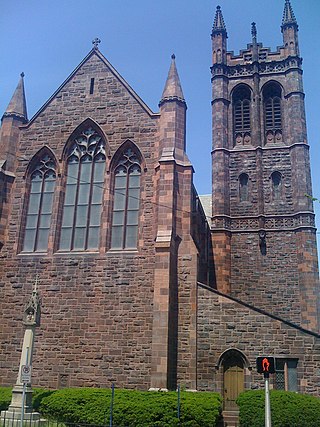
Christ Church, also known as Christ Church New Haven, is an Episcopal parish church at 70 Broadway in New Haven, Connecticut. Christ Church follows an Anglo-Catholic style of worship and has a strong focus on urban ministry. The parish began as an offshoot from New Haven's Trinity Church, the central Episcopal church on New Haven's town green.

Trinity Episcopal Church is located in Covington, Kentucky, Madison Avenue. This historic church was founded November 24, 1842, in a third floor of a brick building near the Covington market. The cornerstone of the first church was June 24, 1843 and the first service was on June 30, 1844. The church has served the people of Covington and Cincinnati, Ohio through wars and floods. The church is active today, with a large congregation at its Fourth and Madison Avenue location. The Rev. Peter D'Angio is the rector. It is the second largest parish in the Episcopal Diocese of Lexington.
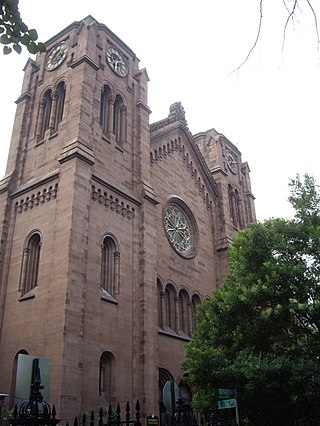
St. George's Episcopal Church is a historic church located at 209 East 16th Street at Rutherford Place, on Stuyvesant Square in Manhattan, New York City. Called "one of the first and most significant examples of Early Romanesque Revival church architecture in America", the church exterior was designed by Charles Otto Blesch and the interior by Leopold Eidlitz. It is one of the two sanctuaries of the Calvary-St. George's Parish.
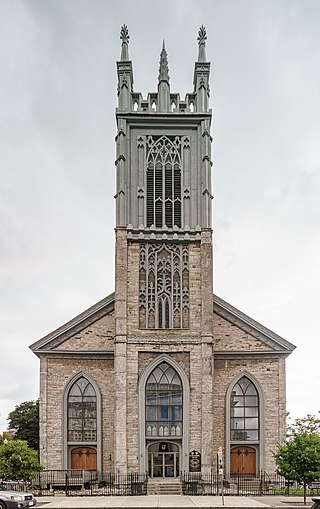
St. Paul's Episcopal Church in Troy, New York, United States, is located at Third and State streets. It is home to one of the oldest congregations in the city. In 1979, the church and two outbuildings were added to the National Register of Historic Places. Seven years later, when the Central Troy Historic District was created and added to the Register, it was listed as a contributing property.
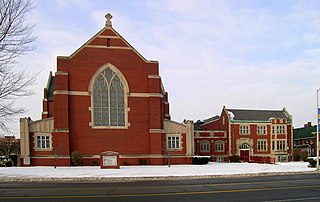
The St. John's Christian Methodist Episcopal Church is a church located in Detroit, Michigan. It was built as the North Woodward Congregational Church, listed on the National Register of Historic Places in 1982, and designated a Michigan State Historic Site in 1998.

Trinity Episcopal Church is a historic church in Mobile, Alabama, United States. It was the first large Gothic Revival church built in Alabama. The building was designed by architects Frank Wills and Henry Dudley.

This is a list of the National Register of Historic Places listings in Detroit, Michigan.

Grace Episcopal Church is the second oldest Episcopal congregation in Chicago, Illinois, United States. Since December 1985 it has occupied its 6th location, in a former printing works located at 637 South Dearborn Street in the Printer's Row neighborhood. Now also called Grace Place, the historic 3-story redbrick late 19th century Arts and Crafts building is a contributing property in the South Dearborn Street-Printing House Row North Historic District. Grace Place is also listed in the City of Chicago's Chicago Landmarks Historic Resources Survey.

St. Andrew's is a historic Episcopal church at 247 New Milford Turnpike, in the Marbledale village of Washington, Litchfield County, Connecticut. Built in 1822, it is believed to be one of the first Gothic Revival style churches to be built in rural Connecticut. It was listed on the National Register of Historic Places in 1994.

St. John's Episcopal Church is a historic church at 92 Main Street in the Warehouse Point section of East Windsor, Connecticut. Built in 1804, its interior was extensively restyled in the second half of the 19th century to resemble a Gothic English country church. The building, still in active use by the original congregation, was listed on the National Register of Historic Places in 1982.

Holy Trinity Episcopal Church also known as Holy Trinity Memorial Church is an historic Episcopal church building located at 38 Grand Avenue in the village of Swanton, Franklin County, Vermont. Built in 1876 and expanded in 1909-10, the church facilities include a fine example of the Carpenter Gothic in the older section, and the Late Victorian Gothic Revival in the newer section. The church was listed on the National Register of Historic Places as the Parish of the Holy Trinity in 2001. The church is an active parish in the Episcopal Diocese of Vermont; its current rector is the Rev. Reid D. Farrell.

St. Paul's Episcopal Cathedral, is located in downtown Des Moines, Iowa, United States. It is the cathedral church of the Episcopal Diocese of Iowa. The building was listed on the National Register of Historic Places as St. Paul's Episcopal Church.

St. Paul's Episcopal Church is a parish church in the Diocese of Iowa. The church is located in Durant, Iowa, United States. The church building and parish hall have been listed on the National Register of Historic Places since 1985.

Emmaus United Methodist Church, originally built as Calvary Methodist Episcopal Church, two of five names it has gone by in its existence, is located at Morris and West Lawrence streets in Albany, New York, United States. It is a brick Collegiate Gothic building constructed in the early 20th century. In 2008 it was listed on the National Register of Historic Places.

Trinity United Methodist Church is located in Des Moines, Iowa, United States. It was listed on the National Register of Historic Places in 1998 as Trinity Methodist Episcopal Church, which was its previous name.

St. John's Episcopal Church is a historic church at 768 Fairfield Avenue in Bridgeport, Connecticut. Built in 1873 for a congregation founded in the mid-18th century, it is a well-preserved design of James Renwick Jr. and a good example of late 19th-century Gothic Revival architecture. It was listed on the National Register in 1984.

























